Wednesday August 14, Prague Tour part I
Our personal “tour guide”, is waiting for us early in the morning outside the hotel door, with an all-day ticket valid for all the means of public transport (value for money).
Our first stop is at the Jewish cemetery, located at the Jewish Quarter. The region is also called Josefov, named after the Emperor Joseph the Second, whose reforms improved the living conditions for the Jews.

The cemetery was one of the few places in the city where Jews were allowed to be buried. So, when it was full, the new tombs were constructed on the top of the existing ones! It is estimated that about 200,000 people have been buried here, with the first gravestone dated back to 1439 and the last burial took place in 1787.

There are many myths and legends in Prague. One of them, is that a Golem is said to be hiding in the attic of the Old-New Jewish Synagogue. It is a powerful being made of clay, which according to the legend, was created by Rabbi Lev to protect the Jewish Quarter. The Golem inspired Tolkien in the namesake character of his book.
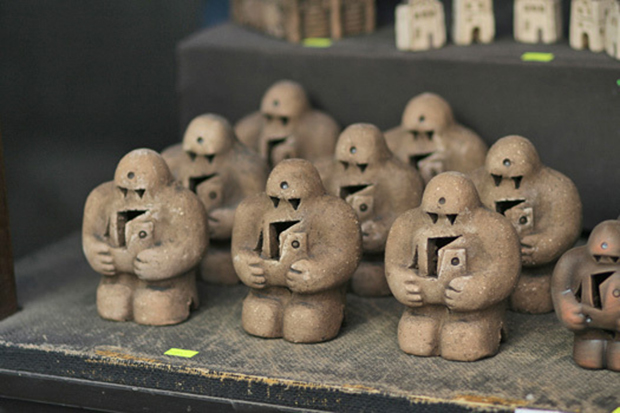
Next stop is a not so well known church according to our guide. The one of St. James with the legend of stuffed hand.

The legend says that once a robber had tried to steal money from the church. The statue of the Virgin Mary raised its hand, grabbed him and held him until the authorities came and arrested him. The robber was amputated and his arm is hanging over the door.
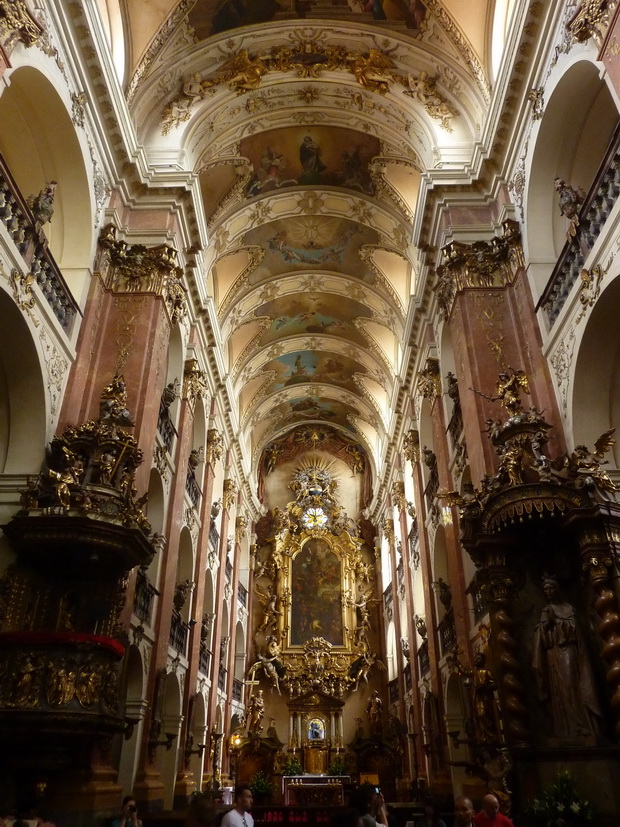

Inside the church there are amazing frescoes and statues, all made by the top Czech painters and sculptors of the 17th century.

A few yards away is the central square of the old city (Starometske Namesti). Whichever building you look at, is simply amazing and each one has its own history.

First things first. The famous astrological clock (source: wikipedia).
The Orloj is mounted on the southern wall of Old Town City Hall in the Old Town Square. The clock mechanism itself is composed of three main components: the astronomical dial, representing the position of the Sun and Moon in the sky and displaying various astronomical details; “The Walk of the Apostles”, a clockwork hourly show of figures of the Apostles and other moving sculptures-notably a figure of Death (represented by a skeleton) striking the time; and a calendar dial with medallions representing the months.

The oldest part of the Orloj, the mechanical clock and astronomical dial, dates back to 1410 when it was made by clockmaker Mikuláš of Kadaň and Jan Šindel, the latter a professor of mathematics and astronomy at Charles University.
Later, presumably around 1490, the calendar dial was added and clock facade decorated with gothic sculptures.
In 1552 it was repaired by Jan Taborský, clock-master of Orloj, who also wrote a report on the clock where he mentioned Hanuš as maker of the clock. The clock stopped working many times in the centuries after 1552, and was repaired many times. In the 17th century moving statues were added, and figures of the Apostles were added after major repair in 1865-1866.

This is what is happening every hour, when the clock rings!
The Orloj suffered heavy damage on May 7 and especially May 8, 1945, during the Prague Uprising, when Germans directed incendiary fire from several armored vehicles and an anti-aircraft gun to the south-west side of the Old Town Square in an effort to silence the provocative broadcasting initiated by the National Committee on May 5. The hall and nearby buildings burned along with the wooden sculptures on the Orloj and the calendar dial face made by Josef Mánes. The machinery was repaired, the wooden Apostles restored by Vojtěch Sucharda, and the Orloj started working again in 1948, but only after significant effort.
Formerly, it was believed that the Orloj was constructed in 1490 by clockmaster Jan Růže (also called Hanuš); this is now known to be a historical mistake. A legend, recounted by Alois Jirásek, has it that the clockmaker Hanuš was blinded on the order of the Prague Councillors so that he could not repeat his work; in turn, he broke down the clock, and no one was able to repair it for the next hundred years.
According to local legend the city will suffer if the clock is neglected and its good operation is placed in jeopardy.
At the square you can also admire the church of Our Lady of Tyn, with two beautiful twin bell towers distinguished from almost anywhere in the city. It was built in the 14th century and was the main place of worship of foreign traders who visited the city.
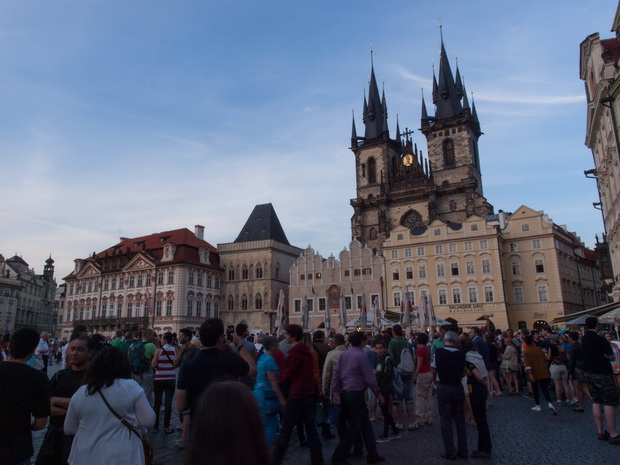
In the center of the square stands the statue of Jan Hus, which was raised on July 6, 1915 to mark the 500th anniversary of the death of the reformer. The growing stream of supporters of Hus’ ideas during the 14th and 15th century led eventually to Hussite wars. Despite the initial disapproval for the modern style of sculpture, the statue stands as a symbol of Czech identity.

Less important but still beautiful are the old Town Hall, the church of St. Nicholas, the Tiny House, the Stone Bell House and the Statue of Mary.
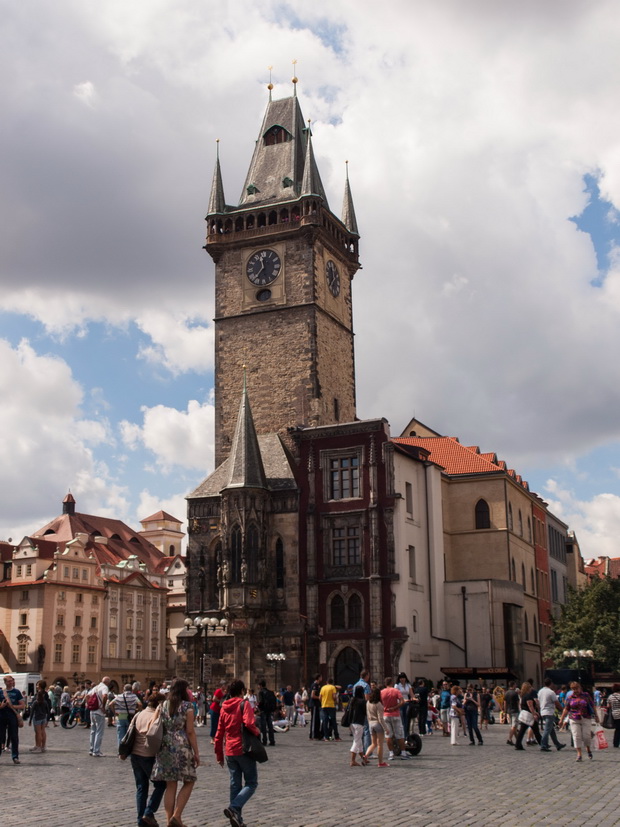
The old Town Hall

The Tiny House in which lived the Czech writer Franz Kafka
After we had finished with the square attractions, we headed towards another famous sight of the city: the Charles Bridge over the Vltava River.

This impressive building houses the information office for tourists.

The corners of the most buildings are decorated with various statues like the one in the photo. This way they used to protect the corners of the building from the wheels of the horse wagons.
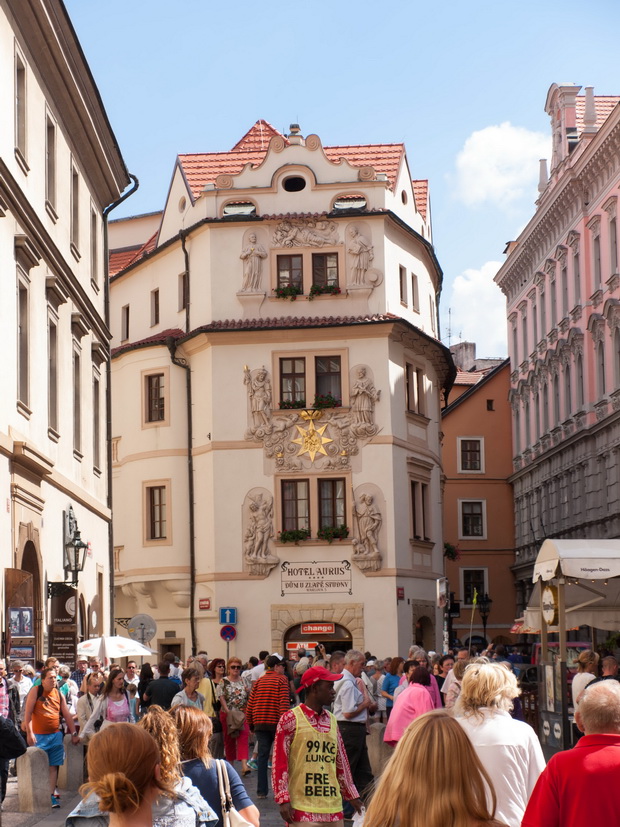
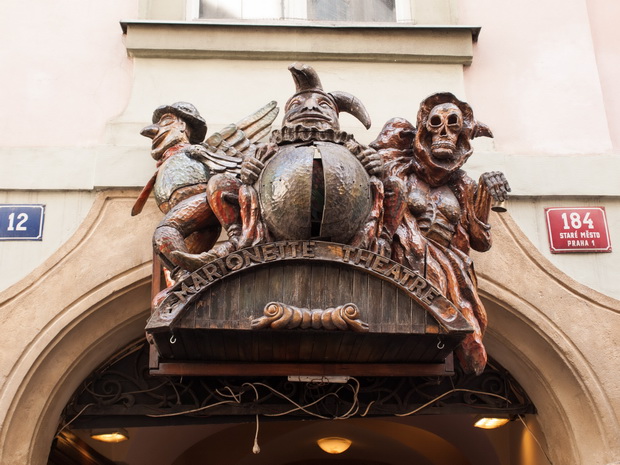

Just before the bridge, there is the statue of King Charles. I raise my camera and Jan pulls my arm saying: “Come, there is a better angle.” You got the point …

The construction of the bridge began in 1357 under the aegis of King Charles IV and ended in the early 15th century. It was the most important connection between the Old Town and the surrounding areas until 1841 and made Prague an important hub for the trade route between Eastern and Western Europe.



The bridge is 516 meters long and nearly 10 meters wide. It is arched with 16 arches supported by 15 pedestals. In its entire length, it’s decorated with 30 statues and sculptures, most of them dated from 1700. Some of them can be seen at the photos below:

This statue was crafted by Matej Vaclav Jackal, and is dated from 1709. St. Bernard kneels before the Virgin Mary, and a host of angels accompany her.
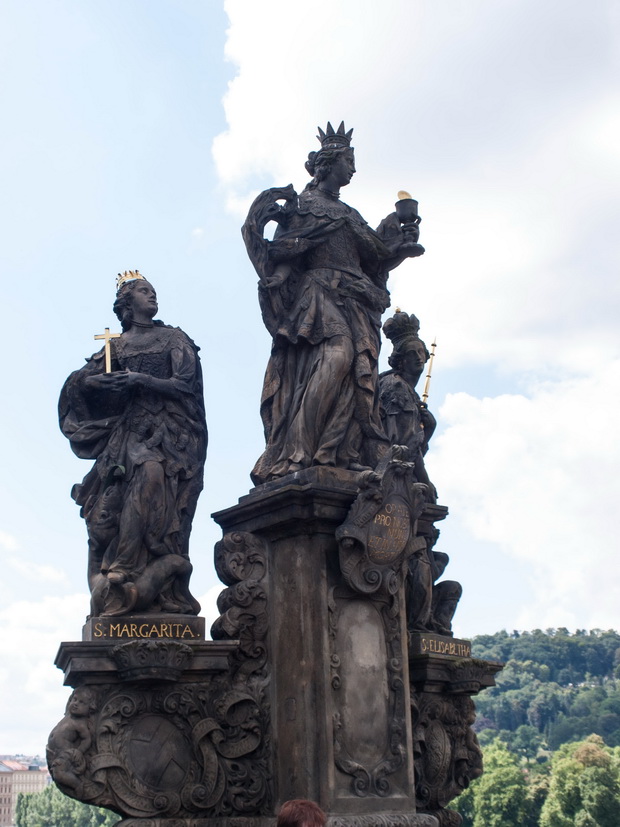
Saint Barbara is the patron Saint of Miners, and a church in nearby Kutna Hora, a former mining town, is dedicated to her. St. Elizabeth is show on the left of St. Barbara, while St. Margaret is on the right.

At this 1708 statue by Matej Vaclav Jackal, the Virgin Mary presents a rosary to St. Dominic and St. Thomas Aquinas. Symbols of the Dominican Order are incorporated into this statue.
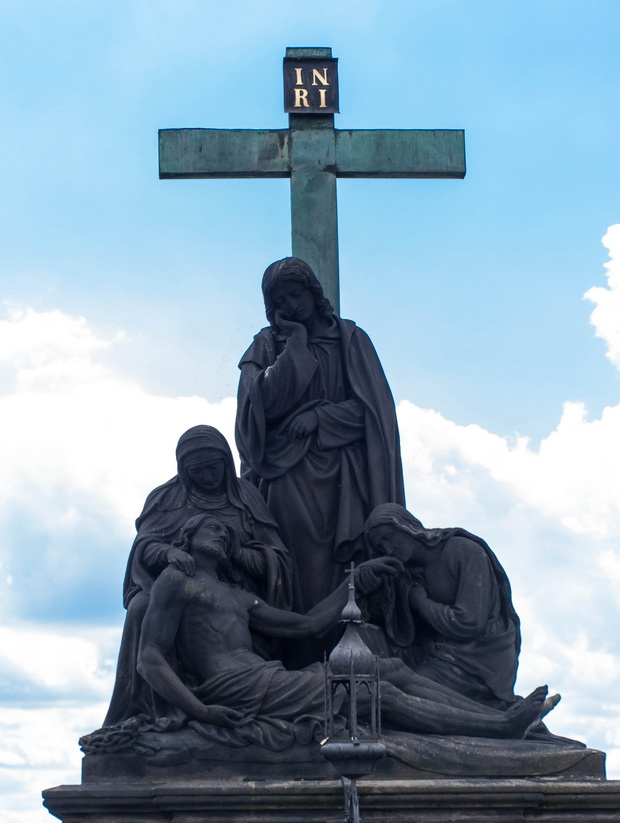
The statue of the Pieta, or the Lamentation of Christ, a statue at Charles Bridge was a site of executions in the past. The statue dates from 1859 and was sculpted by Emmanual Max.

The original statue (made of wood) that stood in the place of the present Crucifixion statue predates even the statue of St. John of Nepomuk. Christ on the Cross stood alone until statues of the Virgin Mary and John the Evangelist were added in the 19th century.
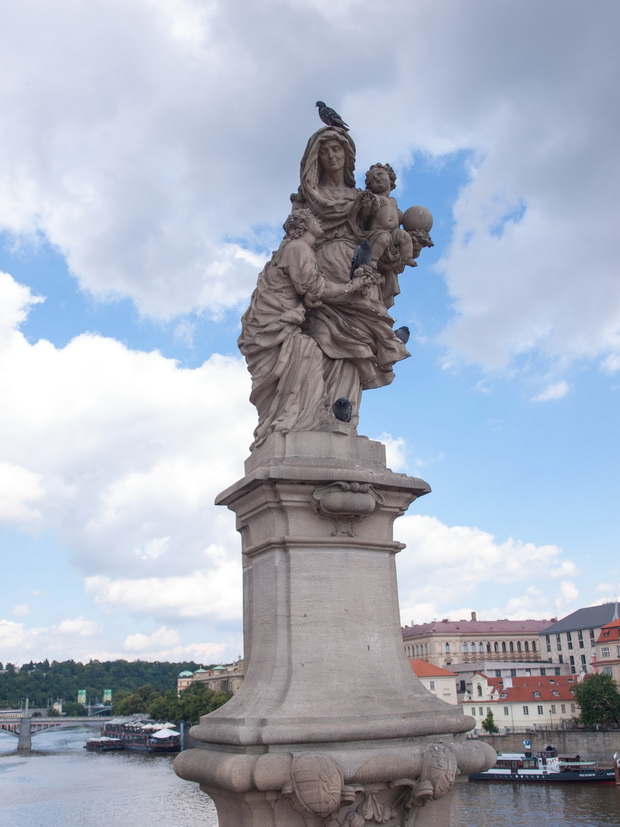
St. Anne, the mother of the Virgin Mary, is seen here in this 1707 statue by Matej Vaclav Jackel holding baby Jesus, who in his turn holds a sphere representing the globe.
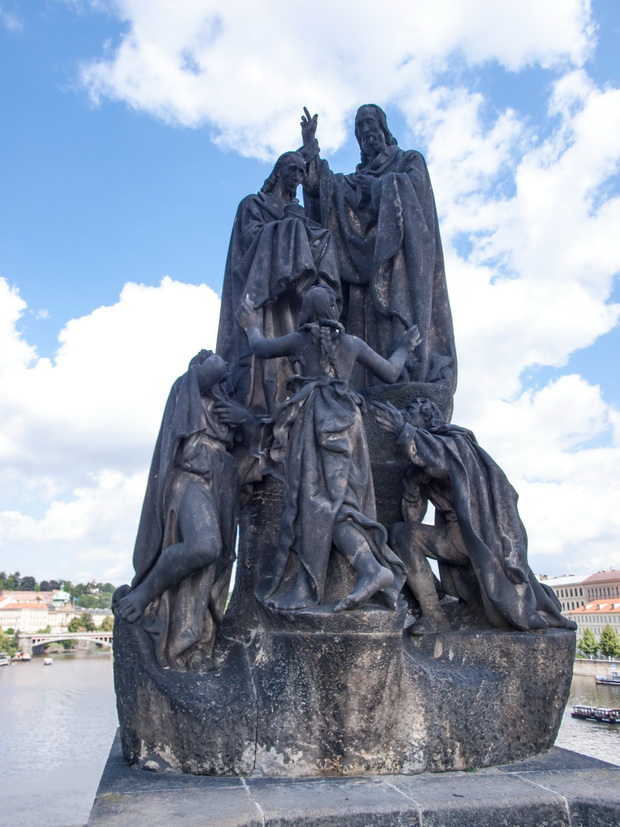
Cyril and Methodius are important figures in East and East Central Europe. Credited with inventing the Cyrillic alphabet, they also brought Christianity to the Slavic people. The statue, created by Karel Dvorak in the 20th century, shows Cyril and Methodius as educators.

St. Francis Xavier is known for his work in the East, and he is shown here with four non-European princes who he is converting to Christianity.

St. Christopher is often depicted with a stick carrying Jesus as a child on his shoulder, and this traditional image is reinterpreted in this statue from 1857 by Emmanual Max.
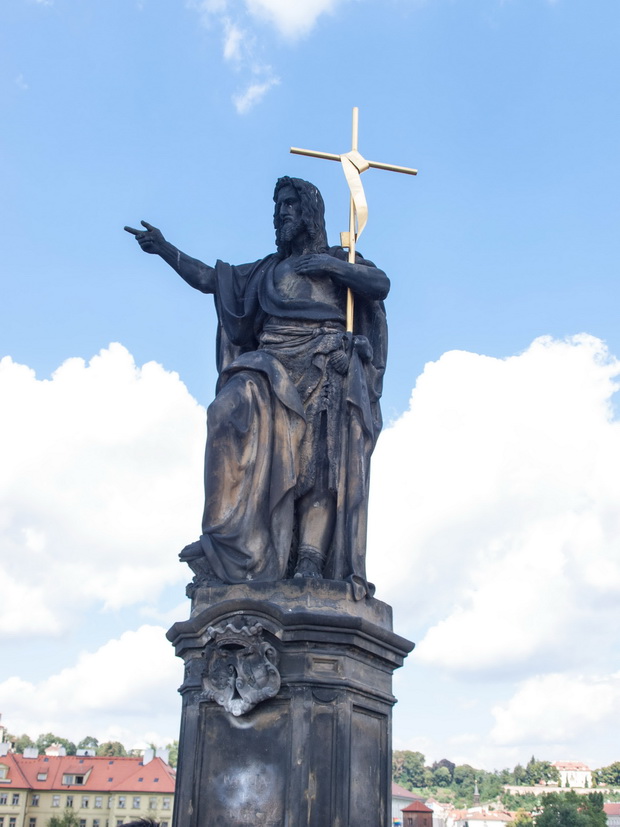
Also sculpted in 1857 by Josef Max, the statue of St. John the Baptist depicts St. John holding a cross.

The statue of St. John of Nepomuk is particularly important to the Prague history. One of the oldest statues on Charles Bridge, this statue was placed on the bridge in 1683 to commemorate the saint. St. John of Nepomuk was a religious figure in St. Wenceslas’ court in the 14th century but was thrown from Charles Bridge to his death in the Vltava River.

The reliefs below the statue of St. John of Nepomuk illustrate scenes from his life. There is a legend saying that good luck, and a promise of a return trip to Prague, comes to those who touch these reliefs.

St. Vitus, patron saint of dancing and other theatrical callings, is depicted in a Roman dress. Hungry lions climb a rock to reach the saint, signifying his demise. This statue was created by Ferdinand Brokoff in 1714.
After we crossed the bridge really slow, photographing every corner of it, we moved on to another city landmark, the castle. It is one of the largest, oldest, inhabited castles in the world.

Its story begins in the 9th century and as usual, every king or conqueror made his modifications to the castle. A big fire destroyed a large part of it in 1541 but it was rebuilt in its present form first under the reign of the Habsburgs and then by Empress Maria Theresa of Austria in the second half of the 18th century.

In 1918, the castle became the seat of the President of Czechoslovakia. During the Second World War and the German occupation, Prague Castle became the headquarter of Reinhard Heydrich. It is said that he placed on his head the Crown of Bohemia, believing that he was a great king, and according to old legends, the one who would wear the crown on his head was doomed to die within a year. In less than a year after, Reinhard Heydrich was assassinated.
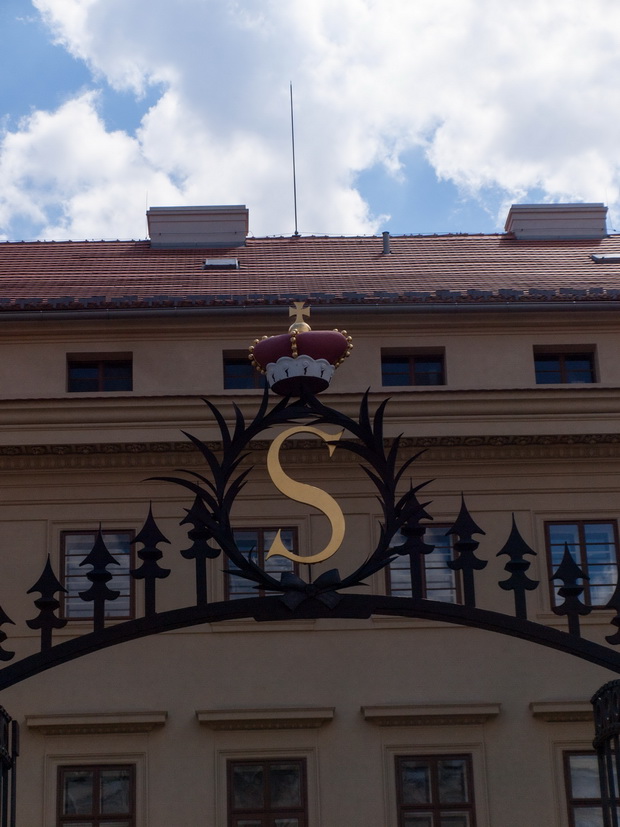
After the liberation of Czechoslovakia, the castle housed the offices of the communist government, and later on became the seat of the Presidents of the Czech Republic.

Our “guide” knows what is worth seeing so he saves us from unnecessary costs by buying only tickets for the highlights. Before we get in, we make a stop at the entrance to see the changing of the guards.
At the point where the changing of the guards takes place, some gorgeous giant statues representing a titanic battle are located.

First attraction, inside the castle, is the Cathedral of St. Vitus.

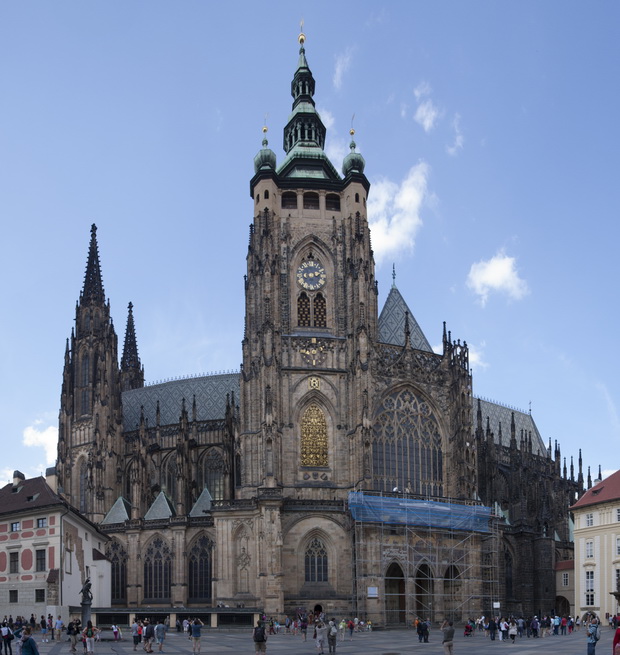
Prince Wenceslas originally built here a small rotunda on the ruins of a pagan temple, which he dedicated to St. Vitus. Τhe construction of the great cathedral began in 1344, headed by the French architect Eye d’ Ara. Ηowever, the architect died and Charles IV commissioned Peter Parler to finish the project. The construction was once again stopped due to the Houssite Wars and was finally completed in 1929.




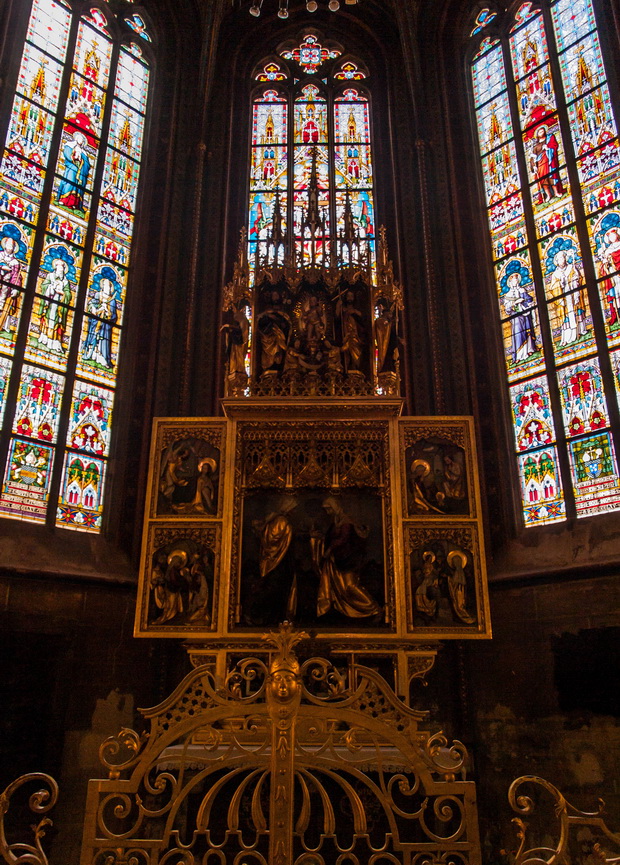

The tomb of St. John of Nepomuk with the 1680 kg silver coffin!
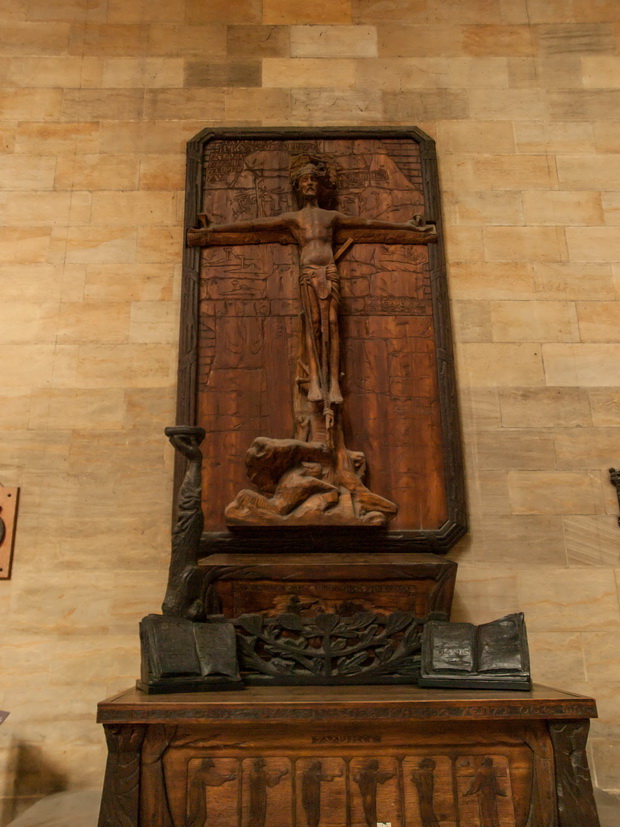

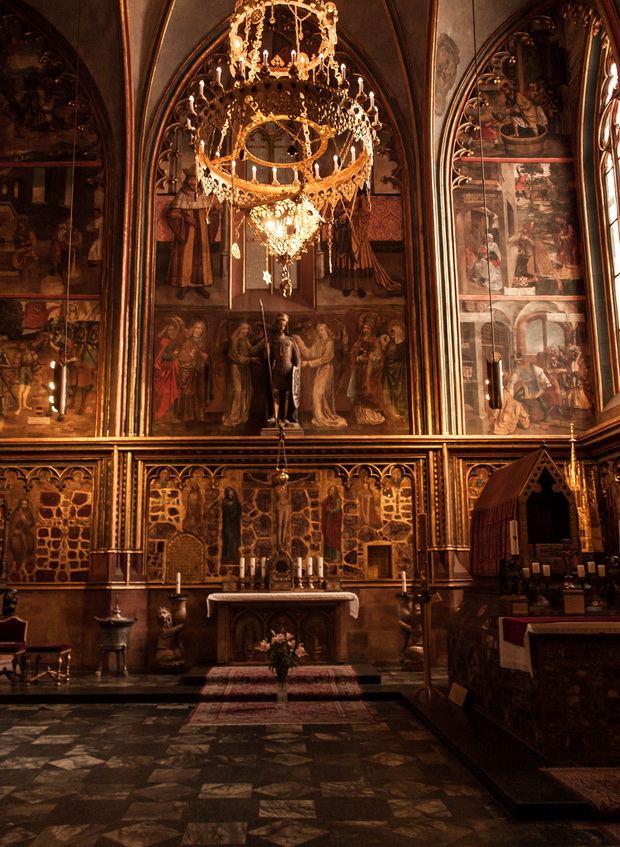
The crown and the scepter of Bohemia are kepted inside the church.
After we had finished with the church, we headed to the old Royal Palace. It was originally a wooden fort built by Prince Borivoj, but the later commanders with their interventions brought it to its present form. The Knight’s Stairway is impressive , with low steps and arched dome, which gives a triumphant tone to the entrance of knights on horseback in the Vladislav Hall, for jousts.

A door in the hall’s southwestern corner leads to the former offices of the Bohemian Chancellery (České kanceláře). On 23 May 1618, in the second room, Protestant nobles rebelling against the Bohemian estates and the Habsburg emperor threw two of his councilors and their secretary out of the window. They survived, as their fall was interrupted by the dung-filled moat, but this Second Defenestration of Prague sparked off the Thirty Years War.

Photo stollen from net…
Next stop is the White Tower, which hosts a torture chamber and a huge collection of armor and weapons.



And then we continue to the Golden Lane, with the tiny houses, which were the residences of the 19th century goldsmiths.

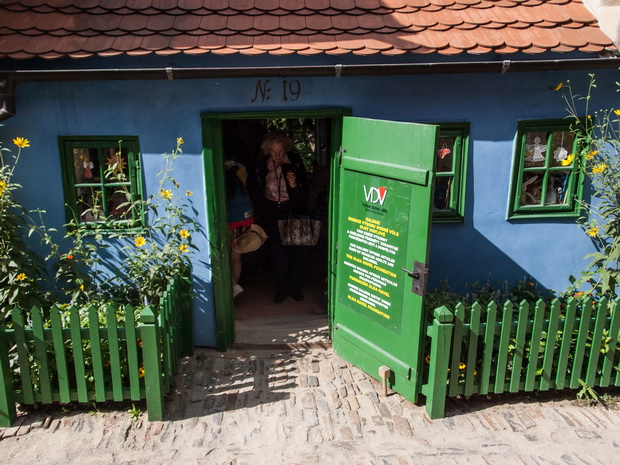

At No. 22 is the house of the famous Czech writer Franz Kafka. In fact it was the house of his sister, but he lived and wrote there for a while.
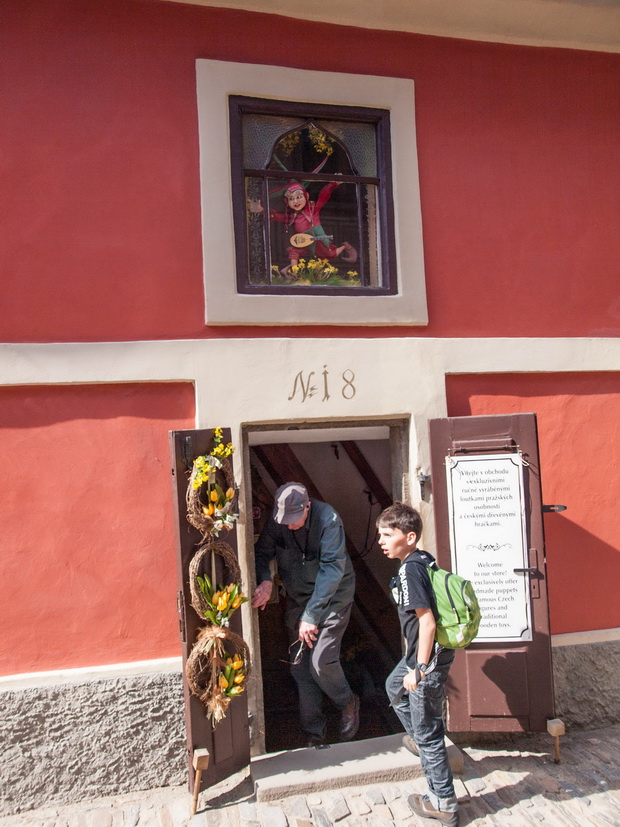
Last thing we visited in the castle, was the Tower Dalibor. The Dalibor was the Czech version of Robin Hood and was the first to be arrested and imprisoned in this castle.

Late in the afternoon we return to the old city. Jan asks us if we are hungry. We answer negatively, but he continues: Nearby, there is a restaurant-pub that makes the strongest beer in the world…
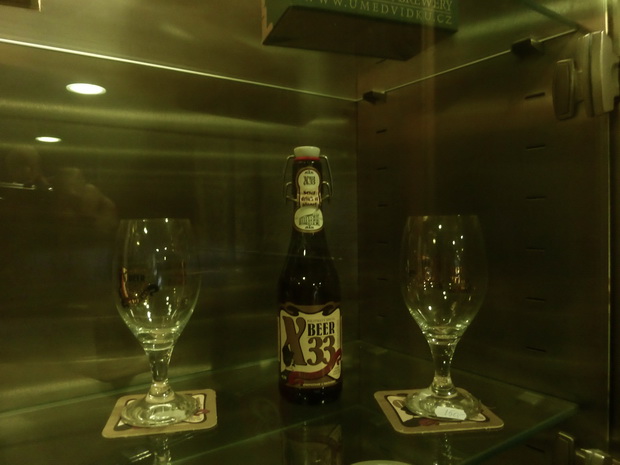
I think he already knows us well… As we are beer lovers, we could not resist the temptation. So we enter the huge U Medvídku. It has 5 different rooms for beer and food. But because we wanted the specific one, they led us to the second floor in a room with some tables around the brewery. We tried the local delicacies and left the beer for dessert, as they advised us to do.

The taste was sweet and strong. Each sip was like falling in the stomach. The percentage of alcohol was 11.8%. The website of the brewery confirms Jan’s words , mentioning that they produce the strongest beer in the world. But according to ratebeer.com, the beer is not included in the 50 strongest, with the most strongest touching the unbelievable number of 65% alcohol…

When we had finished our beers, Jan wanted to show us “his” sport, Archery. The practice site is near, on an island in the Vltava river alongside Charles Bridge. Of course we wouldn’t miss the opportunity to give it a try …

Blame the strong beer for our bad shots…
After some shots, we continued sightseeing at the west side of the river. We crossed a small small park and ended up in front of John Lennon’s wall.

The graffiti on the wall began in 1980 after the assassination of John. Originally, there was his portrait and lyrics of his songs, but it was expanded with messages of peace and various other unrelated graffiti. During our visit a young girl was painting a huge heart accompanied by initial letters, destroying much more essential things that were already on the wall.


The wall is cleaned every now and then by the authorities, but soon enough it is refilled with slogans like… All I can say, just give peace a chance… or even better:
A little further we come across the “Venice” of Prague or as the locals call it, the channel of the devil. Small bridges with forgotten locked locks (loves) lead from one island to another.

Beside them, there are some old watermills and a green statue of a water spirit (Vodník in Czech). The legend says that there are good and bad Vodníks and they always appear next to the water. The good ones try to protect people from drowning, while evils are the collectors of souls of the drowned.

Further down we meet the narrowest street in Prague and one of the narrowest in the world. So narrow that it needs traffic lights for pedestrians…

A bit more further lies a quirky attraction, located in the courtyard of a restaurant. I don’t think a description is necessary…
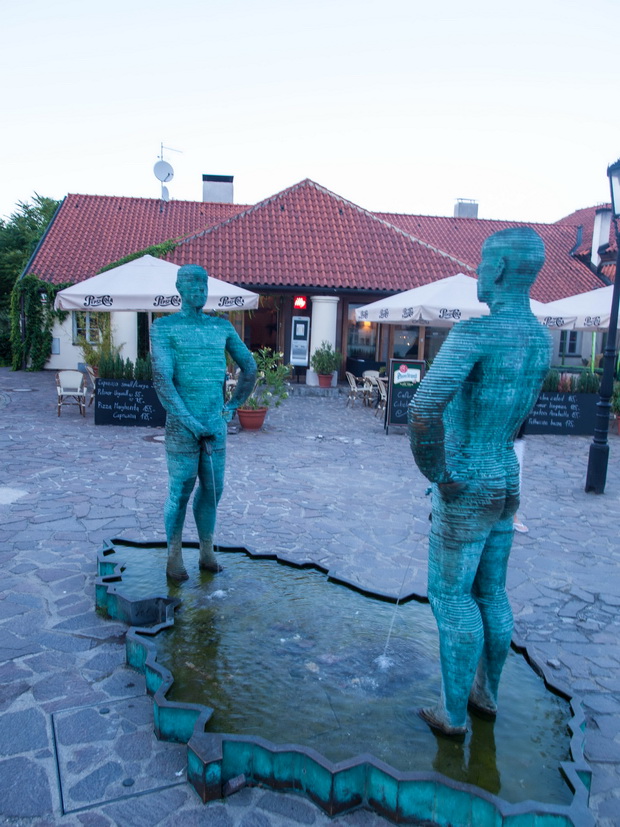
And this ends our first day tour at the city. We saw so many things today thanks to our guide, Jan. If we didn’t have Jan, I think we would need at least two days in order to see the same things. But let’s go to celebrate it with a beer along with another friend, Chonza.
Late at night (or early in the morning) we return really tired at our hotel. I think that I slept in a sec…
| « Previous Page | Next Page » |





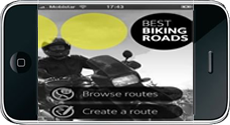



Μπραβο παιδια παντα τετοια ,
Ταξιδευω απο το 1992 με rd 350 στην αρχη fzr1000 ,hayabusa αργοτερα και απο περυσι t max500 yamaha.
Σας διαβαζω γιατι φετος θα ειναι η πρωτη φορα που θα περασω απο βαλκανια.
Λοιπον ας ειμαστε ολοι καλα να απολαμβανουμε αυτο το μοναδικο που σου κανει η μοτοσυκλετα , να σε κανει 18 χρονων με το που ξεκινας το ταξιδι
Ευχαριστούμε Χρήστο…
Είμαι σίγουρος πως θα περάσεις υπέροχα. Τα Βαλκάνια κρύβουν απίστευτες ομορφιές.
Οι μοτοσυκλέτες είναι “μηχανές του χρόνου” τελικά 😉
Πραγματικά πολύ όμορφο ταξιδιωτικό, φέτος είμασταν και εμείς στο περίπου!!! Το μόνο που έχω να πω σαν διευκόλυνση, αν δεν το έχετε κάνει ήδη, πιστεύω ότι είναι καλύτερα να πηγαίνεις μαυροβούνιο μέσω κοσόβου. Δηλαδη σκόπια, κόσοβο, μαυροβούνιο. Εχω πάει ήδη 2 φορές από αυτην την διαδρομή και με αυτά που βλέπω από αλβανία είναι πολύ καλύτερη από άποψη δρόμων. Δεν υπάρχει κανένας κίνδυνος, απλά βγάζεις μια ασφάλεια 15 ευρώ που ισχύει για 15 μέρες πριν μπεις στο κόσοβο, συνεχίζεις μεχρο ουροσεβατς και απο εκει αριστερα να περασεις τα σύνορα για μαυροβουνιο. Λιγα παραπάνω χλμ αλλα που βγαίνουν πιο εύκολα και πιο γρήγορα.
Έχεις δίκιο Γιώργο. Μαυροβούνιο – Κόσοβο – Σκόπια είναι πολύ πιο εύκολα. Εμείς επιλέξαμε Αλβανία γιατί θέλαμε να κάνουμε την ορεινή διαδρομή Kukes-Peshkopi, η οποία είναι κα-τα-πλη-κτι-κή, αλλά όλα τα περίχωρα είναι δράμα…
Όπως και να ‘χει, όλα είναι μια εμπειρία. Ταξίδι να είναι και όπου να’ ναι!
Καλούς δρόμους να ‘χουμε
ΠΟΛΥ ΚΑΛΟ ΚΑΙ ΑΝΑΛΥΤΙΚΟΤΑΤΟ.ΕΙΝΑΙ ΤΕΛΙΚΑ ΞΕΣΗΚΩΜΟΣ ΝΑ ΔΙΑΒΑΖΕΙ ΚΑΝΕΙΣ ΤΑ ΤΑΞΙΔΙΩΤΙΚΑ ΣΑΣ.ΤΟ ΚΑΛΟ ΕΙΝΑΙ ΝΑ ΕΧΕΙ ΠΟΚΙΛΙΑ ΤΟ ΤΑΞΙΔΙ ΚΑΙ ΑΥΤΟ ΕΙΧΕ ΣΥΝΔΙΑΣΜΟ ΟΛΩΝ(ΣΑΛΩΝΙΑ-ΑΛΩΝΙΑ).ΤΕΛΙΚΑ ΔΕΝ ΘΑ ΠΑΩ ΠΟΤΕ ΠΟΡΤΟΓΑΛΙΑ ΑΠ’ΟΤΙ ΦΑΙΝΕΤΕ…ΠΑΛΙ ΣΤΑ ΒΑΛΚΑΝΙΑ ΘΑ ΒΡΕΘΩ….
Να ‘σαι καλά Γιώργο. Τα Βαλκάνια όντως μας έλκουν σαν μαγνήτης. Έχουν κάτι το μαγικό που όλο μας κάνουν να στρέωουμε τις ρόδες μας προς τα εκεί. Ίσως είναι το ανεκμετάλευτο ακόμα παρθένο τοπίο που σε συνδιασμό με τους αυθαιντικούς ανθρώπους που δεν σε κοιτάνε σαν κομπόδεμα. Ένα είναι σίγουρο πάντως… Πως και οι δικές μου ρόδες σύντομα θα ξανατραβήξουν ξανά προς τις Βαλκανικές χώρες. Έχω κάνει 5-6 ταξίδια εκεί, αλλά έχω ακόμα πολλά να δω.
Πολλά ευχαριστώ & πολλά μπράβο στην παρέα!!
Να είστε καλά παιδιά!!Πάντα τέτοια!!
Να είστε γεροί να ταξιδεύετε!!
Ευχαριστώ για το χρόνο & την ενέργεια που δαπανήσατε για να το μοιραστείτε!!
Τέτοια ταξιδιωτικά αποτελούν πολύτιμο διάλλειμα & πηγή πληροφοριών για κάθε επίδοξο ταξιδιώτη.
Ευχαριστούμε Κωστή 😉